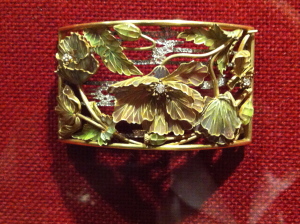 The turn of the 20th century saw an explosion of new design movements throughout the world. These movements go by different names in different countries: Art Nouveau, Arts and Crafts, Jugendstil, Secessionist, Wiener Werkstatte, Sconvirke. These movements also coincide with, or overlap, the Edwardian era which is named for the reign of King Edward VII in England (1901-1910).
The turn of the 20th century saw an explosion of new design movements throughout the world. These movements go by different names in different countries: Art Nouveau, Arts and Crafts, Jugendstil, Secessionist, Wiener Werkstatte, Sconvirke. These movements also coincide with, or overlap, the Edwardian era which is named for the reign of King Edward VII in England (1901-1910).

With the exception of Edwardian jewelry with its delicate tracery of diamonds and platinum, the other design movements are often characterized by the minimal use of precious materials; the emphasis instead is on flowing lines (sometimes contrasted with hard-edged geometry), color, and symbolism. There are several excellent books on jewelry of this era:

Jewelry and Metalwork in the Arts and Crafts Tradition by Elyse Zorn Karlin, is a great book on the jewelry of these design movements. Although strongest on jewelry produced in England – where the movement is referred to as “Arts and Crafts” – the book also has chapters on France, Germany, Austria, Scandinavia, and the United States. The book is currently out of print, but available through the Amazon Marketplace and specialty booksellers.
Vivian Becker’s Art Nouveau Jewelry is another great broad-based book with chapters on the jewelry of France, Germany and Austria, England, and the United States. The opening chapter is a superb introduction to the historical precedents, influences, characteristic motifs, and materials used in Art Nouveau jewelry. There are also excellent appendices containing biographies of the artists and showing maker’s marks.

Around 1900 the city of Pforzheim was the center of jewelry manufacturing in Germany, so a great deal of the jewelry produced there was in the Art Nouveau style, known as Jugendstil in Germany and Austria. Art Nouveau Jewelry from Pforzheim (Jugendstil-Schmuck aus Pforzheim) by Fritz Falk begins with a series of essays about the history of jewelry in Pforzheim and follows with eighteen chapters about individual firms.

Growing out of the slightly earlier Secessionist movement, and with many overlapping participants, the Wiener Werkstatte (Vienna Workshops) was a cooperative of Viennese artists begun in 1903. Wiener Werkstatte Jewelry is the publication that accompanied a major exhibition of Wiener Werkstatte jewelry at the Neue Galerie in New York in 2008. The book is available through the Amazon Marketplace and specialty booksellers.

While not exclusively about Art Nouveau jewelry, The Glitter and the Gold, Fashioning America’s Jewelry by Ulysses Grant Dietz is focused on jewelry produced in the United States during the 19th and early 20th centuries, specifically on fine jewelry produced in Newark, New Jersey. From about 1850-1950 Newark was the fine jewelry manufacturing capital of the United States, with its heyday being the late 19th and early 20th centuries. So, while the time period covered in this book is greater than the Art Nouveau era, its focus is coincides with it. The book is available through the Newark Museum’s Bookstore.
Some great information on Art Nouveau, Arts and Crafts, and Edwardian jewelry is also available on Lang Antiques Antique Jewelry University.
Most of the books I mentioned above are available via Amazon or through J.M. Cohen Rare Books, a dealer who specializes in books about jewelry and fashion who I met at Jewelry Camp.
If you have any favorite books on jewelry of the era I’d love to hear from you.
ShareFollow
